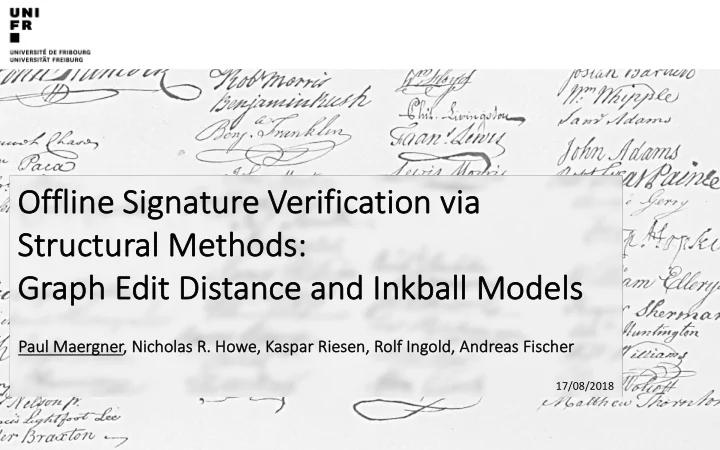

Of Offline Si Signature Verification via St Struct ctural Methods: s: Graph Edit Distance and Inkb kball Models Pa Paul Ma Maergner, , Nicholas R. . Howe, , Ka Kaspar Ri Riesen, , Rolf Ingo gold, , Andreas Fi Fischer 17/08/2018
Offline Signature Verification Reference Images Test Image Accept or Reject References Comparisons Decision 2
Statistical vs. Structural Approach (x 1 , … , x n ) Statistical – Feature vectors � large number of mathematical methods available � fixed-size representation 3
Statistical vs. Structural Approach Our Approaches (x 1 , … , x n ) Statistical – Feature vectors Structural – Graphs � large number of mathematical � flexible representation � binary relations methods available � fixed-size representation � high computational complexity 4
Two recent structural approaches Graph-based Signature Verification Framework Introduced by Maergner et al. at ICDAR 2017 Bipartite approximation of graph edit distance Keypoint graphs Inkball Models Introduced by Howe at ICDAR 2013 Rooted tree and efficient matching algorithm Never been applied to Signature Verification à Use both methods individually and combined 5
Keypoint graphs vs. Inkball models 6
Keypoint graphs vs. Inkball models Both Models – Similar Nodes End-/Junction points + additional points Keypoint graphs – Edges Edges connect neighboring points on the skeleton Not all parts of the graph are connected, contains circles Inkball models – Edges Rooted tree (no circles, all parts are connected) Nodes are greedily connected to the nearest nodes à Similar Representations 7
Keypoint Graph 8
Inkball Model 9
Matching 10
Graph Edit Distance Approach: Overview Reference Image Graph Representation 0.786 Graph Matching Dissimilarity Score Graph Representation Test Image 11
Graph Edit Distance (GED) GED between ! " and ! # 7 $ ! " , ! # = (+ , ,…,+ . )∈1(2 , ,2 3 ) 4 min 8(9 5 ) 56" Υ(! " , ! # ) Set of edit paths 8(9 5 ) Cost of edit operation 9 5 Edit operations Substitution/deletion/insertion of nodes and edges 12
Inkball Model Approach: Overview Reference Image Inkball Model 0.473 Inkball Matching Dissimilarity Score Test Image Skeleton Image 13
Inkball matching Reference Test Flexible Parts: Distribute Strain: Rigid Model: Model Better Fit Best Fit Poor Fit 14
Signature Verification Score 15
Dissimilarity Score ! ", $ Reference Signatures " Test Signature 7 Normalization: Intra-User Variability %(") = 1 |"| + 2∈.\4 !(5, 6) min ,∈. Accept if ! ", 7 < 9 , Reject else. !(5, 7) Dissimilarity Score: ! ", 7 = min %(") ,∈. 16
Multiple Classifier System (MCS) Simply linear combination with weight ! • Dissimilarity scores are z-score normalized • based on reference signatures .∈0 ! 1 2 (8, )) + (1 − !) 1 2 ∗ ∗ "MCS ,' (, ) = min "GED "inkball (8, )) 17
Evaluation 18
Evaluation Protocol Datasets MCYT-75 and GPDS-75 (GPDSsynthetic-Offline) Skilled forgeries (SF) Forgers with access to the genuine signatures Random forgeries (RF) Signatures of other users; brute force attack Two tasks R5/R10 using 5/10 genuine signatures per user as reference Evaluation Measure Equal Error Rate (EER) 19
Equal Error Rate Results – Test Protocol 1 Skilled Forgeries Random Forgeries System GPDS-75 MCYT-75 GPDS-75 MCYT-75 R5 R10 R5 R10 R5 R10 R5 R10 Maergner et al. 11.96 9.42 20.36 14.40 4.90 3.60 6.25 2.92 ( ! = 1.0, GED app.) Proposed Inkball 14.09 10.36 12.98 10.49 7.75 5.51 5.19 3.46 ( ! = 0.0 ) 20
Equal Error Rate Results – Test Protocol 1 Skilled Forgeries Random Forgeries System GPDS-75 MCYT-75 GPDS-75 MCYT-75 R5 R10 R5 R10 R5 R10 R5 R10 Maergner et al. 11.96 9.42 20.36 14.40 4.90 3.60 6.25 2.92 ( ! = 1.0, GED app.) Proposed Inkball 14.09 10.36 12.98 10.49 7.75 5.51 5.19 3.46 ( ! = 0.0 ) Proposed MCS 9.42 6.84 13.07 8.71 3.66 2.05 3.06 1.24 ( ! = 0.4 ) 21
Equal Error Rate Results – Test Protocol 2 Average EER over ten random selections of 10 reference signatures GPDS-75 R10 MCYT-75 R10 System RF SF RF SF Ferrer et al. 0.76 * 16.01 0.35 * 11.54 Maergner et al. (GED app.) 2.73 8.29 2.83 12.01 Proposed Inkball ( ! = 0.0 ) 5.22 10.64 3.13 8.29 Proposed MCS ( ! = 0.4 ) 1.99 6.67 1.88 7.20 *: All genuine signatures of other users as RF 22
Equal Error Rate Results – Test Protocol 3 EER Results with a posteriori user-dependent score normalization MCYT-75 R5 MCYT-75 R10 System RF SF RF SF Alonso-Fernandez et al. 9.79* 23.78 7.26* 22.13 Fierrez-Aguilar et al. 2.69** 11.00 1.14** 9.28 Gilperez et al. 2.18* 10.18 1.18* 6.44 Maergner et al. (GED app.) 2.40 14.49 1.89 11.64 Proposed Inkball ( ! = 0.0 ) 2.88 9.33 2.02 8.53 Proposed MCS ( ! = 0.4 ) 0.92 9.07 0.52 5.78 *: All genuine signatures of other users as RF **: First 5 genuine signature from each other user as RF 23
Conclusion Two structural methods for signature verification inkball models used for the first time Excellent signature verification performance for skilled forgeries on MCYT-75 and GPDS-75 room for improvement for random forgeries Combination achieves best results two complementary methods 24
Outlook Further develop structural representations other types of nodes and edges improved cost functions Include stability models which parts of the structure are stable? Make matching visible for human expert 25
Thank you for your attention! Questions? 26
Recommend
More recommend